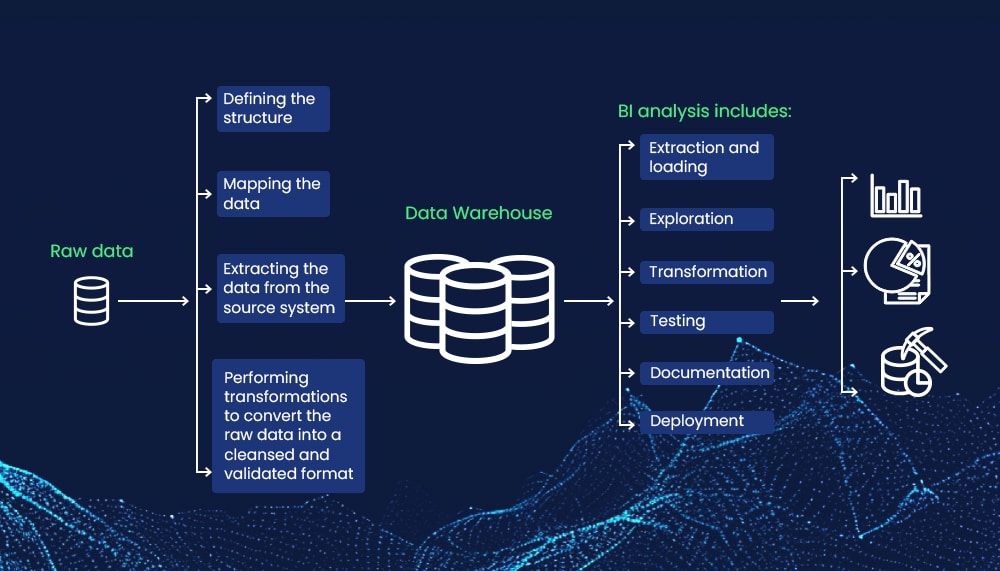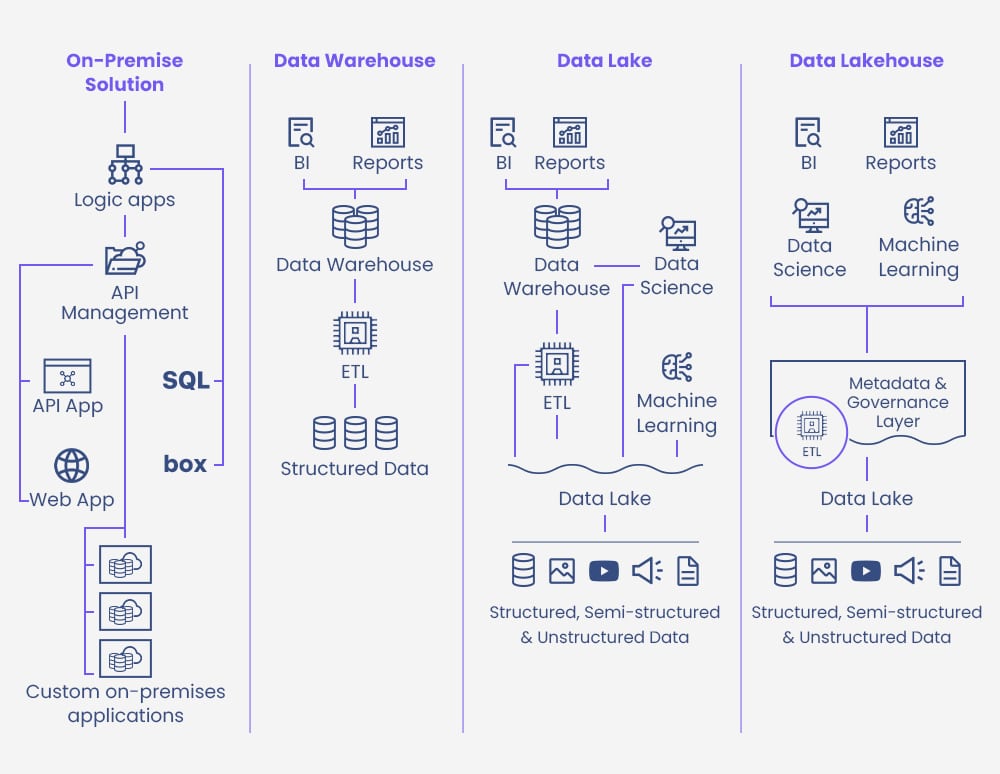Why are data warehouses and business intelligence pivotal in generating business insights and shaping strategic business decisions?
The main reasons for data analytics are process improvement and cost efficiency – 60%.
According to a recent study covering five countries, the main reasons for using data analytics are to improve processes and reduce costs. In addition, most users answered “strategy and change” (57%). The third most common use of data analytics is to monitor and improve financial performance (52%).
As you can see, it is clear that data warehouse and business intelligence provide great savings for companies.
This article breaks down the synergy between storing extensive data in a data warehouse and using BI tools to distill it into insights that drive intelligent, forward-looking decisions. A robust data warehouse is essential for supporting BI, as it consolidates all the data from various sources, ensuring comprehensive analysis and reliable business intelligence.
Data Warehouse and Business Intelligence Systems Key Takeaways
- Data warehousing and business intelligence (BI) systems are symbiotic. They rely on seamless integration to analyze data and enable data-driven decisions, supported by architectures designed to organize and process large volumes of data efficiently and to support analytical and reporting activities.
- Business intelligence software performs crucial functions such as data analysis, creating visualizations, dashboards, and predictive analytics, and business reporting to convert data into actionable insights for decision-making, with modern tools offering advanced features that empower non-technical users.
- Data security in data warehousing and BI systems is critical, necessitating adherence to best practices and compliance with HIPAA, GDPR, and CCPA regulations to prevent unauthorized access, breaches, and legal repercussions.
Unlocking Insights: The Symbiosis of Data Warehousing and Business Intelligence
Data warehousing and business intelligence (BI) tools are interlinked, functioning cohesively rather than as separate entities. They work together to provide a framework that allows users to:
- Comprehend business dynamics
- Effectively analyze data
- Enable informed and data-driven decisions
- Generate insights that foster rapid and strategic decision-making
Business intelligence architecture leans heavily on smoothly integrating reliable data from data warehouses to achieve these goals. Data warehouses serve as the foundation for consolidating data from multiple sources, ensuring consistency and quality. By consolidating data, organizations enable comprehensive analysis and reporting.
In this process, structured information from data warehouses is used for complex queries and analysis, such as online analytical processing (OLAP), to gain insights into different aspects, like campaign revenue and success factors. This data is then interpreted to develop strategies and optimize operations, which is where business intelligence tools come in. These tools primarily aim to transform substantial amounts of data into actionable insights.
“Most of our clients rely on a data warehouse and data transformation to produce dashboards that will give them better business insights,” says Ovais, Analyst Engineer at Data-Sleek.
For example, insights derived from data warehousing could help identify top customers or uncover profitable opportunities by analyzing relevant data, enabling more informed, evidence-based business decisions.
The Backbone of BI: Understanding Data Warehouses

Business intelligence systems rely heavily on the solid foundation provided by data warehouses. A data warehouse stores data from disparate sources, integrating information from across the organization into a centralized repository. By providing the raw data that is subsequently analyzed by BI systems, data warehouses play a crucial role in extracting valuable insights that drive business decisions. Given the importance of data warehouses, their design is of utmost importance.
An efficient and robust cloud data warehouse will ensure high data throughput, offer quick and adaptable query capabilities, and allow data manipulation to meet various analytical needs.
The Structure of Data Storage
“A common question we encounter with our customers is how a data warehouse differs from a database,” says Franck, CEO at Data-Sleek.
The answer lies in their design and purpose. A data warehouse is engineered explicitly for executing queries and analysis, housing extensive historical data, and prioritizing read operations. In contrast, a database is optimized for transaction processing involving frequent write operations.
The structure of data storage varies among different database types. For instance, relational databases store data in tables and rows, while OLAP databases use a column store engine. The main elements of data storage in a data warehouse comprise:
- A central database
- ETL tools
- Metadata
- Access tools that oversee and facilitate data processing and retrieval
To ensure efficient data organization, data warehouses use models such as star schema or snowflake schema to establish data relationships, with storage models like base models, intermediate models, core models, and data vaults. These models help organize data from multiple sources into a unified repository, supporting business intelligence and decision-making. Data warehouses store information in a structured format optimized for analysis, making it easier to access and query large volumes of data efficiently.
From Raw Data to Structured Insights
Raw data refers to the initial, unprocessed information gathered directly from the source of data collected prior to any processing, cleansing, or analysis. The transformation of raw data into structured information in data warehousing involves:
- Defining the structure
- Mapping the data
- Extracting the data from the source system
- Performing transformations to convert the raw data into a cleansed and validated format.
The first 3 steps are also referred as data integration.
The data transformation process for BI analysis includes:
- Extraction and loading
- Exploration
- Transformation
- Testing
- Documentation
- Deployment
This transformation is facilitated by tools that prepare raw data for use. Techniques such as data mining, data modeling, data analytics, data visualization, and data storytelling may be employed to analyze and present the data, converting it into actionable and significant information.
Interested in learning how Data-Sleek can address your organization’s data management challenges? Schedule a free, no-obligation consultation with one of our experts today!
The Mechanics of BI Tools: Transforming Data into Decisions

The strength of BI tools is anchored in their proficiency in scrutinizing data and yielding actionable insights. The primary functions of business intelligence software include data analysis, the creation of intuitive visualizations and dashboards, and performing predictive analytics, reporting, and data mining. These functions are crucial in extracting actionable information from data, aiding businesses in making informed decisions.
Visualizing the Future: Predictive Analytics and BI
Predictive analytics in business intelligence serves to assist businesses in improving their decision-making processes to maximize profitability and efficiency. It achieves this by:
- Employing data modeling and statistical algorithms
- Predicting future outcomes and offering forecasts
- Enabling informed decision-making through data analysis
- Identifying patterns and trends
- Providing valuable insights
Predictive analytics contributes to forecasting trends by utilizing historical data, machine learning algorithms, and statistical methods to recognize correlations and patterns in datasets and project future events. This capability allows organizations to anticipate future occurrences based on their past data.
Integrating the Pieces: Data Integration in BI Architecture
Data integration in the realm of both business analytics and intelligence encompasses the consolidation of diverse information sources to furnish a cohesive perspective. This entails:
- The extraction of data from various systems
- The transformation of data
- The loading of data into data warehouses through ETL (extract, transform, and load) processes.
ETL – The Lifeline of Data Warehousing
ETL processes play an integral role in data warehousing. ETL involves extracting data from diverse source systems, transforming the data into a suitable format, and loading the transformed data into the data warehouse. These data warehouse processes ensure the data is prepared for analysis and reporting.
Implementing automation for ETL processes within data warehousing is feasible and can be achieved by utilizing specialized ETL automation software or tools. These tools streamline the ETL procedures by reducing manual effort and enabling more consistent and error-free data handling.
Cloud Evolution: The Rise of Cloud Data Warehouses

Advancements in cloud computing technologies have significantly driven the proliferation and adoption of cloud-based data warehousing solutions. Cloud data warehousing has matured, transitioning from on-premises operation to leveraging the cloud’s enhanced scalability, flexibility, and cost-effectiveness.
Comparing On-Premise and Cloud Solutions
When deciding between on-premise and cloud-based enterprise data warehousing solutions, it is essential to consider the inherent characteristics and advantages of each.
On-premise data warehouses offer:
- Direct control
- High-performance speed
- Robust security measures
- Governance
- Continuous availability
On the other hand, cloud-based data warehouses are centralized platforms for storing and processing data operated within a public cloud infrastructure. They offer services for handling:
- structured and semi-structured data
- integration
- cleansing
- loading
The decision between the two largely depends on an organization’s specific needs and resources.

Advanced Analytics: AI and Machine Learning in Data Warehousing
Incorporating AI and machine learning technologies into data warehousing has fundamentally transformed the efficiency and quality of the insights produced. AI enhances efficiency in data warehousing by analyzing data from multiple sources and automatically generating data models, thereby enhancing data accuracy and completeness. It also aids in improving data quality and consistency by automating data cleansing and validation processes.
The success of AI and machine learning integration in data warehousing is evident in:
- Advanced data mapping and transformation capabilities
- Automated processes
- Integration with data science workflows
- Real-time data ingestion and retrieval using SQL.
Navigating the Data Lake: When to Choose a Data Warehouse Over a Data Lake
Data warehouses and data lakes are two different kinds of data storage management systems, each with its unique strengths. A data lake is a massive repository of both structured and unstructured data, whereas a data warehouse only stores structured, refined data.
Choosing between a data lake and a data warehouse depends on the organization’s specific data usage requirements. Data warehouses are most suitable for handling structured data for consistent, standardized reporting and analysis. On the other hand, data lakes are well-suited for storing extensive and diverse data, which can be maintained in its raw state until required for a range of analytical objectives.
Architectural Considerations: Designing an Efficient Data Warehouse
The design of a data warehouse must consider certain principles, including prioritizing and ensuring the quality and trustworthiness of data, centralizing data storage, and understanding key concepts like facts and metrics.
Well-planned enterprise data warehouse architecture provides a centralized repository for storing, accessing, managing, and protecting business-critical data. This enhances data analysis and decision-making, improves data quality and confidence, and enables scalability and flexibility in data storage.
Factors like indexing and data partitioning also play a key role in operational efficiency. Indexing significantly reduces query response time and enhances overall query performance. At the same time, data partitioning divides the data into more manageable units, enabling parallel processing of queries, thereby reducing response time and enhancing performance.
The End-User Perspective: Business Intelligence for Non-Technical Users
The ease of use of a business intelligence tool greatly influences its adoption and efficacy. Features that contribute to the user-friendliness of BI tools for non-technical users include:
- Resource portal segregation
- Drag-and-drop designers
- Interactive dashboards as user interface
- The ability to share reports and insights with team members
- Robust security
- Support for multiple data sources
- A mobile interface
- The option to schedule emails
Despite the availability of user-friendly tools, non-technical users often encounter obstacles such as technical and project management issues, lack of familiarity with BI tools, and insufficient data literacy. These obstacles can be remedied by providing support from the software provider, offering training and education on BI tools and data literacy, and implementing effective project management strategies.
Securing Your Assets: Data Privacy and Security in Warehousing and BI

Data security is of utmost importance in data warehousing and business intelligence systems. Some typical security issues faced in the management of data warehousing include:
- Unauthorized access
- Theft of company devices
- Hacking
- Malware attacks
- Insider threats
To mitigate these security threats, data warehousing best practices such as establishing precise access controls for authorized users, implementing encryption, and providing comprehensive training can be followed. With regulations such as HIPAA, GDPR, and CCPA in place, data breaches can have serious legal ramifications, including potential litigation and regulatory sanctions, making securing your organization’s data and assets all the more critical.
Real-World Use Case Scenario for Marketing Strategy
A newly formed retail company’s Chief Marketing Officer (CMO) is tasked with marketing its smartphones against intense competition. The goal is to maximize market share and drive sales of the company’s latest flagship smartphone model. Budgets are tight, and every step counts.
The CMO uses BI tools to conduct an in-depth market analysis to understand key market identifiers. Data comes from past sales, market research, test user groups, and market trends. This company’s marketing team will use key identifiers from segmented target audiences to infer insights and develop a strategy.
Based on BI insights and market analysis, the CMO develops target messaging and positioning strategies that resonate with its specific audience segments. BI tools track consumer sentiment and feedback in real-time, allowing the company to adjust its messaging based on the response.

Business Intelligence informs the company which channels, partnerships, and platforms perform best. The marketing team can then allocate resources efficiently to prioritize channels with the highest ROI to maximize its tight budgets.
Throughout the campaign lifecycle, BI tools provide the CMO with real-time performance metrics and KPIs. Measuring the effectiveness of its initiatives allows the company to stay agile and make campaign adjustments as needed.
Leveraging business intelligence to inform marketing decisions allows the smartphone manufacturer to drive sales and maximize market share growth. Targeted marketing campaigns resonate with the right audience segments. Additionally, channel optimization strategies ensure broad reach and effective distribution. Real-time performance metrics enable agile campaign adjustments that ensure optimal results and maximum ROI. Overall, BI tools empower the CMO to make data-driven decisions that optimize marketing efforts and achieve impactful outcomes.
Summary
In the era of big data, data warehousing and business intelligence systems provide a powerful means to navigate the wave of data and extract valuable insights that drive strategic business decisions. They offer a framework that allows users to comprehend business dynamics and effectively analyze data. The evolution and growth of these systems, from on-premises solutions to cloud-based platforms, have been significant. As we continue to harness the power of data, it’s crucial to remember the importance of data security, user-friendly BI tools, and integrating AI and machine learning technologies in data warehousing for improved efficiency and insights.
Take the next steps in your data management journey and book a consultation with one of our experts today!
Frequently Asked Questions
What is business intelligence and data warehouse?
Business intelligence encompasses data collection, methodology, and analysis, while data warehousing involves storing and organizing data to facilitate business intelligence processes. This allows companies to derive actionable business insights from various data sources to aid decision-making.
What relationship between data warehousing and business intelligence may best be described?
The relationship between data warehousing and business intelligence can be described as follows: data warehousing provides the foundation for BI tools to process and analyze data, facilitating data translation into actionable insights and decisions for business intelligence.
What is data warehouse architecture in business intelligence?
Data warehouse architecture in business intelligence is the intentional design of data services and subsystems that consolidate disparate data sources into a single central repository for various analytical purposes.
How does a data warehouse differ from a database?
A data warehouse is designed for queries and analysis, storing extensive historical data and prioritizing read operations, while a database is optimized for transaction processing, involving frequent write operations.
What are the advantages of cloud-based data warehousing solutions compared to on-premise ones?
Compared to on-premise solutions, cloud-based data warehousing offers scalability, cost-effectiveness, integrated security, and analytics services, making it an advantageous option for businesses looking to streamline their data management.


